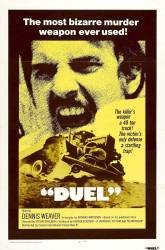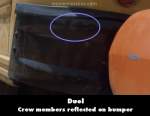Visible crew/equipment: When Dennis Weaver is in the cafe a shadow of a cameraman is cast across the table he is sitting at. The shot then changes to a wider angle to reveal that there isn't anyone near him who could have cast that shadow.

Duel (1971)
Directed by: Steven Spielberg
Starring: Dennis Weaver, Eddie Firestone, Jacqueline Scott, Lou Frizzell
Continuity mistake: On the truck cab's rear window, there is some sort of air conditioning unit installed. In some shots, such as the gas station scene where David Mann is on the telephone, or the railroad crossing scene, the air conditioning unit has a support structure to hold it in place. In the rest of the film however, there is not any support structure to be seen.

Visible crew/equipment: When David's car gets stuck on the bus bumper, the next shot is of the bus' black bumper and the side of the car. At the top of the black bumper there are two people seen in the reflection. The person on the left turns and takes a step to the right.
Trivia: Steven Spielberg "interviewed" over 100 trucks before finding the forboding, evil looking one for the movie.
Trivia: At the end of the film when the truck goes off the cliff, we hear an odd groaning sound. This is a dinosaur growl from an old movie Spielberg likes. Interestingly, this same sound is also used at the end of Jaws as the shark sinks to the bottom of the ocean. Spielberg did this to show that Jaws and Duel would always be closely connected.
Trivia: This film garnered so much critical praise that it was theatrically released in quite a few countries, though it was originally a made-for-TV-movie for NBC in 1972.
David Mann: I'd like to report a truck driver who's been endangering my life.
David Mann: That truck driver's crazy, he's been trying to kill me, I mean it.
Bus Driver: Well, mister, if I was to vote on who's crazy around here, it'd be you.
David Mann: Come on you miserable fat-head, get that fat-ass truck outta my way.
Question: Why did the truck driver want to kill David Mann?
Answer: According to director Steven Spielberg, the trucker was a serial killer, and each of the license plates were trophies from previous victims.
Answer: David pulled ahead of the truck not once but twice. He got to the gas station first, and got served before the trucker. For any normal person this would not be cause to try to murder someone, however the truck driver is an unhinged psychopath who doesn't need much reason to go into an obsessive rage. Add to that the fact that David is driving a much smaller car, and the fact that they're out in the middle of nowhere with nary a cop around, and the truck driver probably saw David as easy prey.
Answer: "It was very common to see semi trucks with a half dozen or so license plates on them, each from a different state." And that's how the psycho trucker got away with it. He could have those 'trophy' plates on the front of the truck in plain sight, and to anyone who saw it, the truck would look like just another big rig with multiple license plates. Nothing out of the ordinary or suspicious about it.
Question: When the character was at the cafe and the truck was there, but he didn't know who the driver was, why didn't he just go and wait by the truck, smash the windshield, fill the gas tank with sugar or water, slash the tyres?
Answer: At that point in the film, the protagonist David Mann is ready to confront the truck driver. When he sees the old Peterbilt truck outside, David mistakenly assumes the truck driver has already entered the diner, so he confronts a likely suspect that he sees at the counter (but he has misidentified the man). The misidentified man takes offense and punches David out. By the time he recovers his senses, David sees the old Peterbilt truck leaving the parking lot. Which means the actual homicidal truck driver never entered the diner in the first place and was waiting outside the whole time. If David had first gone outside to the Peterbilt, there was a good chance the waiting homicidal truck driver would have killed him right there, and the story would have abruptly ended. So, David's misidentification of the truck driver allowed the film to move ahead into its next act.
Yes, I get why the filmmakers did that, but I still think it is a plot hole. If the Dennis Weaver character was afraid of getting killed by the truck driver, I doubt he would have confronted him in the cafe.
Question: Where was David Mann actually going? And where from? As in, which states? He seemed to be travelling for hours even before he met the truck and seemed to have a long way to go yet.
Chosen answer: The movie opens with him in downtown Los Angeles, California, so he's probably from there or somewhere in Southern California. He's heading to Bakersfield, California, which is north, about 2 hours away. In the short story, he's heading to a client in San Francisco. However, in the film he gets off the main freeway running from LA to Bakersfield (IH-5) and takes Highway 14 towards Canyon Country.
Join the mailing list
Separate from membership, this is to get updates about mistakes in recent releases. Addresses are not passed on to any third party, and are used solely for direct communication from this site. You can unsubscribe at any time.
Check out the mistake & trivia books, on Kindle and in paperback.




Answer: It's never explained why but, judging from the numerous license plates from other vehicles attached to his truck, the truck driver is a serial killer and was just targeting people at random and decided to make David his next target.
Trucks used to have to be registered in multiple states if they were going to operate in them. It was very common to see semi trucks with a half dozen or so license plates on them, each from a different state.